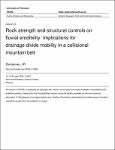Rock strength and structural controls on fluvial erodibility: Implications for drainage divide mobility in a collisional mountain belt
| dc.contributor.author | Zondervan, Jesse | |
| dc.contributor.author | Stokes, M | |
| dc.contributor.author | Boulton, Sarah | |
| dc.contributor.author | Telfer, Matt | |
| dc.contributor.author | Mather, Anne | |
| dc.date.accessioned | 2020-03-26T12:38:47Z | |
| dc.date.available | 2020-03-26T12:38:47Z | |
| dc.date.issued | 2020-05-15 | |
| dc.identifier.issn | 0012-821X | |
| dc.identifier.issn | 1385-013X | |
| dc.identifier.other | 116221 | |
| dc.identifier.uri | http://hdl.handle.net/10026.1/15474 | |
| dc.description.abstract |
Numerical model simulations and experiments have suggested that when migration of the main drainage divide occurs in a mountain belt, it can lead to the rearrangement of river catchments, rejuvenation of topography, and changes in erosion rates and sediment flux. We assess the progressive mobility of the drainage divide in three lithologically and structurally distinct groups of bedrock in the High Atlas (NW Africa). The geological age of bedrock and its associated tectonic architecture in the mountain belt increases from east to west in the study area, allowing us to track both variations in rock strength and structural configuration which influence drainage mobility during erosion through an exhuming mountain belt. Collection of field derived measurements of rock strength using a Schmidt hammer and computer based extraction of river channel steepness permit estimations of contrasts in fluvial erodibilities of rock types. The resulting difference in fluvial erodibility between the weakest and the strongest lithological unit is up to two orders of magnitude. Published evidence of geomorphic mobility of the drainage divide indicates that such a range in erodibilities in horizontal stratigraphy of the sedimentary cover may lead to changes in erosion rates as rivers erode through strata, leading to drainage divide migration. In contrast, we show that the faulted and folded metamorphic sedimentary rocks in the centre of the mountain belt coincide with a stable drainage divide. Finally, where the strong igneous rocks of the crystalline basement are exposed after erosion of the covering meta-sediments, there is a decrease in fluvial erodibility of up to a factor of three, where the drainage divide is mobile towards the centre of the exposed crystalline basement. The mobility of the drainage divide in response to erosion through rock-types and their structural configuration in a mountain belt has implications for the perception of autogenic dynamism of drainage networks and fluvial erosion in mountain belts, and the interpretation of the geomorphology and downstream stratigraphy. | |
| dc.format.extent | 0-0 | |
| dc.language | en | |
| dc.language.iso | en | |
| dc.publisher | Elsevier | |
| dc.rights | Attribution 4.0 International | |
| dc.rights | Attribution 4.0 International | |
| dc.rights | Attribution 4.0 International | |
| dc.rights | Attribution 4.0 International | |
| dc.rights | Attribution 4.0 International | |
| dc.rights.uri | http://creativecommons.org/licenses/by/4.0/ | |
| dc.rights.uri | http://creativecommons.org/licenses/by/4.0/ | |
| dc.rights.uri | http://creativecommons.org/licenses/by/4.0/ | |
| dc.rights.uri | http://creativecommons.org/licenses/by/4.0/ | |
| dc.rights.uri | http://creativecommons.org/licenses/by/4.0/ | |
| dc.subject | collisional mountain belt | |
| dc.subject | drainage divide | |
| dc.subject | rock strength | |
| dc.subject | erodibility | |
| dc.subject | High Atlas | |
| dc.title | Rock strength and structural controls on fluvial erodibility: Implications for drainage divide mobility in a collisional mountain belt | |
| dc.type | journal-article | |
| dc.type | Journal Article | |
| plymouth.author-url | https://www.webofscience.com/api/gateway?GWVersion=2&SrcApp=PARTNER_APP&SrcAuth=LinksAMR&KeyUT=WOS:000525394900012&DestLinkType=FullRecord&DestApp=ALL_WOS&UsrCustomerID=11bb513d99f797142bcfeffcc58ea008 | |
| plymouth.volume | 538 | |
| plymouth.publication-status | Published | |
| plymouth.journal | Earth and Planetary Science Letters | |
| dc.identifier.doi | 10.1016/j.epsl.2020.116221 | |
| plymouth.organisational-group | /Plymouth | |
| plymouth.organisational-group | /Plymouth/Faculty of Science and Engineering | |
| plymouth.organisational-group | /Plymouth/Faculty of Science and Engineering/School of Geography, Earth and Environmental Sciences | |
| plymouth.organisational-group | /Plymouth/REF 2021 Researchers by UoA | |
| plymouth.organisational-group | /Plymouth/REF 2021 Researchers by UoA/UoA07 Earth Systems and Environmental Sciences | |
| plymouth.organisational-group | /Plymouth/REF 2021 Researchers by UoA/UoA14 Geography and Environmental Studies | |
| plymouth.organisational-group | /Plymouth/Research Groups | |
| plymouth.organisational-group | /Plymouth/Research Groups/Marine Institute | |
| plymouth.organisational-group | /Plymouth/Users by role | |
| plymouth.organisational-group | /Plymouth/Users by role/Academics | |
| plymouth.organisational-group | /Plymouth/Users by role/Post-Graduate Research Students | |
| dcterms.dateAccepted | 2020-03-11 | |
| dc.rights.embargodate | 2021-3-23 | |
| dc.identifier.eissn | 1385-013X | |
| dc.rights.embargoperiod | Not known | |
| rioxxterms.versionofrecord | 10.1016/j.epsl.2020.116221 | |
| rioxxterms.licenseref.uri | http://creativecommons.org/licenses/by/4.0/ | |
| rioxxterms.licenseref.startdate | 2020-05 | |
| rioxxterms.type | Journal Article/Review | |
| plymouth.funder | The Geological Remote Sensing Group Student Award::Geological Remote Sensing Group (GRSG) |



